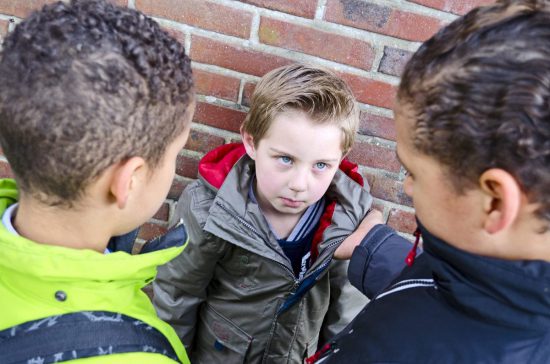“Bullying or just teasing?”
It’s what you ask yourself when your child comes home with a tale of woe, her face streaked with tears, her dress torn, shoes scuffed. But when you try to get a clear picture of what exactly happened, the story she tells between sniffs, snobs, and shaking shoulders just doesn’t add up.
Bullying Or Just Teasing?
Bullying or just teasing? How can a parent tell the difference? Because if there’s anything I know about parenting it’s that sometimes parents must make snap judgments based on scanty information, tone of voice, and body language.
Parents have to apply a certain balance when trying to run down the details. On the one hand, a parent is supposed to protect and defend a child. A parent must get involved when a child is being bullied.
On the other hand, parents must try to distance themselves a bit to get a wider perspective, to make sure they’re getting at the truth. Kids must be taught that a lie will be found out, and that you will not tolerate it should your child attempt to manipulate or distort the facts. And while you are playing Devil’s Advocate, you feel terribly, terribly guilty, for doubting your child.
Bullying or just teasing? You can only pray that you’re making the right decision.
Surely there must be some science to the art of getting at the truth? Well, Carrie Goldman, a blogger at the New York Times, actually came up with an easy-to-remember, formula in a blog piece she called, How Do I Know What’s Bullying And What’s Normal Conflict? Goldman framed her piece by making it personal. She told over the story of what happened to her daughter in the first grade.
Her daughter was happy to go to school, excited even. Then her enthusiasm waned. Goldman could see it in the way she hung her head, seemed dispirited, and cried that she didn’t want to go to school the next day.
Goldman did her due diligence. A boy was calling her daughter “Piggy” and saying nasty things about her weight. Bullying or just teasing? Her gut told her it was the former. But it was very important she run things down and find out what was what. Because if it was merely teasing, well, kids have to work out that stuff without the interference of parental units.
In a case of teasing, you’ve got two kids of equal power, who can eventually work things out. But if a parent gets involved too soon and attempts to “rescue” one of the sides, that disturbs the balance of power.
It’s not fair. And it teaches kids they don’t have to work things out in school, on the playground, and later on, as adults in the office. Because sooner or later, someone will jump in and rescue them.
So, to our formula, worked out by experts (psychologists and researchers), which helps us determine if a given situation is bullying and requires intervention, or whether it is teasing, in which case, the principle people involved (the two children) should be allowed to resolve the situation on their own. According to the formula, three conditions have to be present in order for a situation to be tagged as bullying:
The Behavior is Repetitive: Is it a single incident, or does it happen on a regular basis? Every day, this boy called Goldman’s daughter “Piggy.” So it was not an isolated incident. Goldman checked off that box.
Unwanted Attention: When kids tease each other, a lot of the time, they get goofy. One kid will say, “You a poopy face,” and the other kid will say, “No you a poopy-doopy face,” and both will get the giggles. Goldman’s daughter wasn’t laughing. And when one of the two kids involved is not laughing, the situation can morph from simple teasing into “unwanted aggression,” as Goldman put it. It’s what happens when one side is no longer laughing, and still the teasing continues. That’s not teasing anymore. It’s not fun for both children. It’s hurtful and mean. It’s bullying.
Abuse of Power: A bully always uses an advantage as leverage for inflicting hurt. The bully may be wealthy, his victim less fortunate, or it may have something to do with looks or popularity, for instance. The bully exploits these differences because it makes him feel powerful.
According to Goldman, when all three conditions are satisfied, a fourth element enters the picture and that is fear. The victim looks to find ways to avoid the place or situations in which the bullying occurs. Such was the case with Goldman’s daughter, who wanted to stay home from school.
Goldman’s story had a happy ending. She spoke to the teacher who gave the boy a talking to. It didn’t permanently solve the problem. The next year, it happened again, this time with a different bully and a different teacher. Once again, Goldman spoke to the teacher who gracefully intervened and resolved the situation, hopefully for good.
Not every school is so keen to get involved in a case of bullying. It is for this reason that parents should know the language that identifies the bully and document the situation. Presented with the proof, a teacher will likely be persuaded to get involved in a helpful way, should a child need protection from bullying.
Raising children is not easy. Hopefully, this formula will make things a little bit easier for all of us to understand what’s going on, the next time a child comes home from school or the playground, with a woebegone face.
It takes a village.
